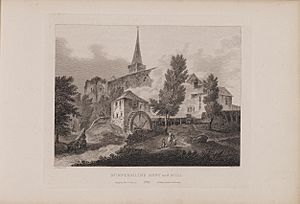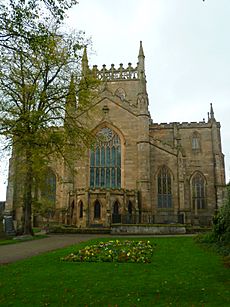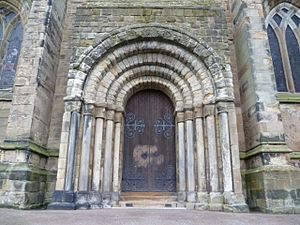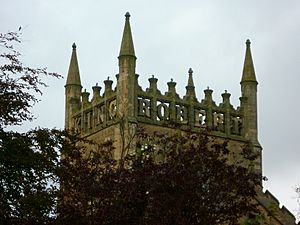Dunfermline Abbey facts for kids
Quick facts for kids Dunfermline Abbey |
|
|---|---|
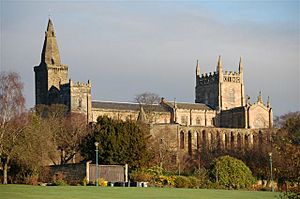
Dunfermline Abbey from Pittencrieff Park
|
|
| 56°04′12″N 3°27′49″W / 56.0699°N 3.4636°W | |
| Location | Dunfermline, Fife |
| Country | Scotland |
| Denomination | Church of Scotland |
| Previous denomination | Roman Catholic |
| History | |
| Status | Active |
| Founded | 1128 |
| Architecture | |
| Functional status | Parish Church |
| Architect(s) | William Burn |
| Style | Romanesque |
| Completed | 1250 |
Dunfermline Abbey is a special church in Dunfermline, Fife, Scotland. It's a Church of Scotland parish church today. This church stands where a huge medieval (meaning very old) Benedictine abbey used to be. An abbey is a place where monks lived and worshipped.
The original abbey was taken over and damaged in 1560 during the Scottish Reformation. This was a time when Scotland changed its main religion. Even though parts were ruined, some of the old abbey church kept being used. Many parts of the abbey buildings are still there today.
Contents
A Look Back at Dunfermline Abbey's History
How the Abbey Began
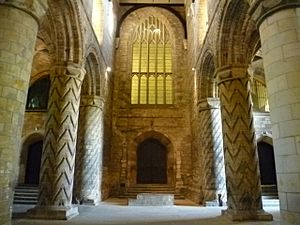
The Benedictine Abbey of the Holy Trinity and St Margaret was started in 1128. King David I of Scotland founded it. But the idea for a monastery here was even older. It came from the time of his father, King Malcolm III, and his mother, St Margaret.
The first leader of the abbey was Geoffrey of Canterbury. He was a monk from England. Dunfermline Abbey became very powerful. It controlled four towns and a lot of land across Scotland.
In the years after it was built, the abbey received many gifts. People built 26 altars inside. These were for private prayers for those who gave money. The abbey was also a very important place for pilgrims. Pilgrims are people who travel for religious reasons. They came to see the shrine of Saint Margaret.
The oldest church foundations are under the amazing Romanesque nave. This part of the church was built in the 12th century. In the winter of 1303, the English king, Edward I of England, stayed at the abbey. When he left the next year, most of the buildings were burned.
Later Years and Changes
During the Scottish Reformation, the abbey church was damaged in 1559 and 1560. By 1563, parts like the choir (where the singers stood) had no roof. It was even dangerous to go inside.
However, some parts of the abbey survived. The large refectory (dining hall) and rooms over the gatehouse are still there. The nave, the main part of the church, was also saved. It was repaired in 1570. Over the years, other parts of the abbey collapsed. The central tower fell in 1753.
The nave was used as the local church until the 1800s. Now, it's the entrance hall for a newer church. This new church opened in 1821. It stands where the old choir used to be. Next to the abbey are the ruins of Dunfermline Palace. This palace was also part of the abbey complex.
Dunfermline Abbey is one of Scotland's most important historical places. Many Scottish kings and queens are buried here. Only Iona has more royal burials. A famous poet named Robert Henryson is also linked to the abbey. The tomb of Saint Margaret and Malcolm Canmore was restored by Queen Victoria.
Dunfermline Abbey Today
The building you see today, where the old choir was, is a Church of Scotland parish church. It is still called Dunfermline Abbey. The minister (the church leader) since 2012 is Reverend MaryAnn R. Rennie.
Amazing Architecture of the Abbey
The old abbey building was a great example of simple but strong Romanesque style. You can see this in the nave. It has a beautiful doorway at its west front. King Alexander I had two towers built next to this main entrance.
Another beautiful Romanesque doorway was found in 1903. This happened when workers were preparing a spot for a memorial. The memorial was for soldiers who died in the Second Boer War. A new spot was found for the monument so the old doorway could be saved. The abbey is looked after by the public. Many people have also given money for beautiful stained-glass windows.
Important Burials and Events
Dunfermline Abbey is a very important burial place for Scottish royalty.
- Saint Margaret of Scotland was buried here in 1093. Her remains were moved to a special shrine in 1250. Her husband, Malcolm III, was also buried next to her.
- Duncan II of Scotland in 1094.
- Edgar of Scotland in 1107.
- Alexander I of Scotland in 1124, and his queen Sybilla de Normandy in 1122.
- David I of Scotland in 1153, and his queen Maud, Countess of Huntingdon in 1130.
- Malcolm IV of Scotland in 1165.
- Several Earls of Angus: Gille Brigte, Earl of Angus, Adam, Earl of Angus, Gille Críst, Earl of Angus, and Donnchadh, Earl of Angus.
- Alexander III of Scotland in 1286. His first wife Margaret of England (1275) and their sons David (1281) and Alexander (1284) are also buried here.
- Elizabeth de Burgh, wife of Robert I of Scotland, in 1327.
- Robert the Bruce was buried here in 1329. His heart is in Melrose, but his bones are at Dunfermline Abbey. His skeleton was found in 1818 and reburied with a special ceremony. A brass marker in the floor shows where his tomb is.
- Matilda of Scotland, daughter of Robert I of Scotland, in 1353.
- Anabella Drummond, wife of Robert III and mother of James I, in 1401.
- Robert Stewart, Duke of Albany in 1420.
- Bishop James Bruce in 1447.
- George Durie (died 1577) has a memorial here.
- Robert Pitcairn (commendator) (died 1584) has a memorial here.
- Charles I, the last British king born in Scotland, was born here in 1600.
- William Schaw, a royal architect, was buried here in 1602. His tomb can still be seen.
- David Lindsay, 1st Lord Balcarres was married here in 1611.
Other Burials
More to Explore
- Abbot of Dunfermline
- Abbeys and priories in Scotland
- List of Church of Scotland parishes
- List of places in Fife
- Robert Henryson
See also
 In Spanish: Abadía de Dunfermline para niños
In Spanish: Abadía de Dunfermline para niños



